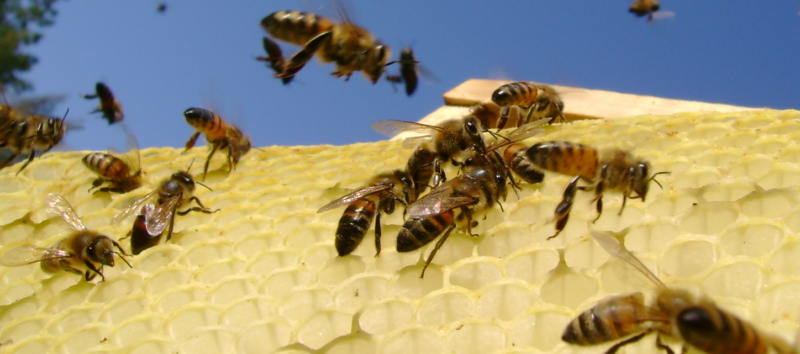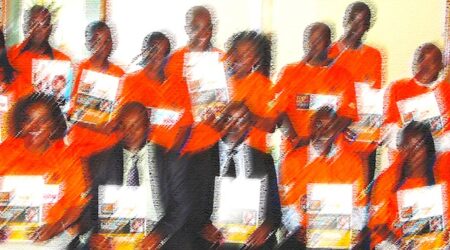Two hundred billion dollars is the current estimated worth of Facebook. It is the amount of money Russia is believed to have spent invading Crimea. It is also the annual value of the global crop production made possible by one important actor: the honeybee.
Alarmingly, honeybees are dying in droves, a crisis that has allied erstwhile enemies like bee enthusiasts, entomologists, environmental activists, and the agricultural industry. What is killing the honeybee, and what is in store for the crops that depend on it?
Hundreds of researchers in academia, government, and agriculture have launched research projects focusing on specific diseases, toxins, or habitat changes that might be endangering the bee. But one bee-keeper, Jake Kosek, Assistant Professor of Geography at UC Berkeley, approached the problem from a different angle.
Kosek has kept bees for years as respite from his academic work, which mostly centers on the relationships between race, nation, and the natural environment (he has written two books and was recently awarded tenure). Yet after his own bees began to die, the barrier between Kosek’s academic life and his bee-keeping hobby quickly eroded. “As I taught histories of chemical warfare, the politics of military drones, and the industrialization of the airscape… the apian elements…kept distracting me,” Kosek explained in a talk for the Shaping San Francisco public lecture series in May 2014.
Kosek soon initiated his own pathbreaking examination of the long history of the bee and its recent decline. Through his students, he came to know biologists and bee specialists working on campus, such as Clare Kremen, Miguel Altieri, and Gordon Frankie. Microbial biologist Ignacio Chapela and Kosek became friends and interlocuters as Kosek reconciled his expertise in political geography and entomology. “They push me really hard, more than anything else, and it has made for a deeply interdisciplinary project,” he explained in an interview.
The university and department soon provided support for Kosek to create his own entomological laboratory on the rooftop of his offices at Berkeley. As Kosek grew increasingly immersed in the debates over whether pesticides, diseases, or loss of habitat had endangered the bees, he began to wonder: how did the bee become so vulnerable in the first place?
Killer Bees
A surprising lead emerged while Kosek was wading through various theories on colony collapse disorder. Some biological and agricultural scientists researching colony collapse had argued that toxins were the culprit. They reasoned that bees instinctively collect and deposit pollen in their hive, a mechanism that poisons colonies when the pollen contains traces of toxins. While entomologists and environmentalists had researched means to mitigate this threat, Kosek found that one group of scientists had set out to exploit this particular bee behavior: U.S. military researchers.
Through ethnographic and archival research at military bases like Los Alamos, Kosek found that military scientists had begun experimentally using bees to overcome the difficulty of conducting reconnaissance to discover chemical weapons. If bees collected chemical toxins from their surroundings and brought them back to their hive, they figured, could they be taught to retrieve chemicals used in weapons development?
Some military scientists believed so, and turned bees into a miniature intelligence force. Raising bees in individual cells, the researchers built a militant bee that would smell, salivate, and send messages to other bees upon detecting a chemical of interest. Computers could read and translate this interspecies signal into a remote alarm, turning a swarm of bees into a chemical weapons detector.
Modern military science thus began to transform the bee. Kosek explained in his lecture that the military went so far as to try to “train bees to… make them eat nothing but chemical sources.” Bees have since been used for “everything from plastic explosives, to the tritium used in nuclear weapons development, to land mines,” according to an essay Kosek wrote in 2010.
The U.S. military has deployed 400 hives around military zones around the world since 2006. Stealth, sensitive, and largely unnoticed by the public, the bee served as a model instrument of surveillance to deploy against the nontraditional and incoherent enemy of the War on Terror. Kosek interviewed an agent with the U.S. Department of Homeland Security, who confirmed that the agency was “deploying bees as effective and efficient homeland security detective devices.”
At the same time, Kosek notes, war strategists have applied entomological research to design new deployment techniques. Previously, U.S. military operations had prioritized hierarchy and centrality, but strategists inspired by bees have recently revolutionized human warfare by introducing the concept of “swarming,” valuing mobility, autonomy, and synchronized and continuous communication. Kosek says that “algorithims…derived from the study of insect behavior are actually the algorithims that are used to coordinate drones in warfare. You can trace the history of entomology into the hardware of drones.” In a curious way, bees have transferred knowledge to humans – allowing strategists to “coordinate strikes without people.”
As “bees become militarized,” Kosek explained in his lecture, “militarized humans become apiary.”
The Human Impact
The military usage is just one example of how the bee has undergone significant change in the past century as it became a critical labor force for the global agricultural industry. Kosek insists that “this remaking is not just symbolic. The bee has experienced transformations to its exoskeleton, its nervous system, its digestive tract, and its collective social behavior.”
You need to understand the deep history and the politics of the making of the modern bee to understand how it has been made vulnerable over time.
As humans designed bees to be pollinators that could be observed, trained, and transported, their hibernation cycle shifted, their color changed, and their lifespan shortened. “We have the idea that we’re capturing them in the wild, but in fact they are deeply industrialized,” Kosek explained.
Years of entomogolical and archival research has convinced Kosek that one cannot understand colony collapse apart from its political, economic, and social context. “We often put this problem in the realm of scientists, entomologists, and biologists….dealing with particular diseases,” he explained. “The premise of my research is that those things, although very important, aren’t going to even begin to come to terms with what’s going on with the bees. You need to understand the deep history and the politics of the making of the modern bee to understand how it has been made vulnerable over time. I want ordinary people to think about the politics of the bees, and that’s going to require more than gardening and starting a neighborhood beehive to address it.”
Kosek implores bee-enthusiasts and environmentalists to avoid “greenwashing” the bee controversy by ignoring the human social dimensions. He explains that if we are to understand the death of the bee, we must first understand how human politics and economic interests have reshaped the insects’ biology and environment. As Kosek put it, “To say ‘I’m an environmentalist, that I’m not interested in these social or political issues, [is] basically impossible.”



